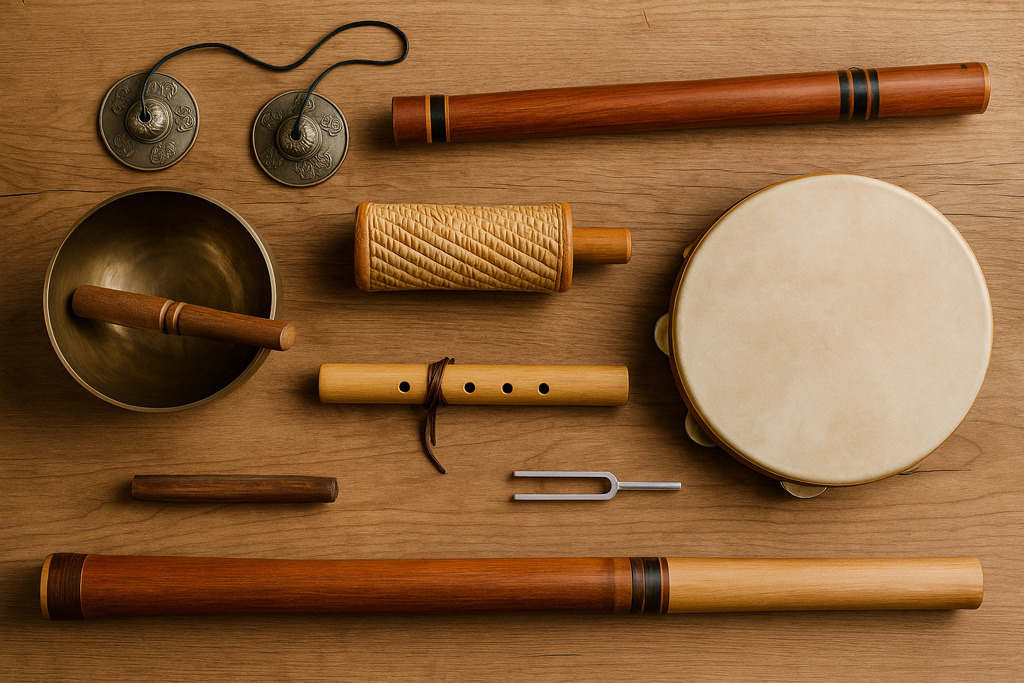Buying Guide: What to Know Before Purchasing a Sound Instrument
Buying a sound healing instrument is not only a financial decision—it is an energetic investment. Each instrument carries its own voice, vibration, and therapeutic qualities. Whether you are seeking a calming singing bowl, a powerful gong, or a grounding didgeridoo, understanding what to look for before purchasing ensures you bring home a tool that resonates with your body, practice, and purpose.

1. Define Your Purpose
Ask yourself: Why do I want this instrument?
- Personal practice: meditation, relaxation, self-healing.
- Therapeutic/professional use: leading sound baths, working with clients, or integrating into yoga/therapy sessions.
- Performance and creative work: concerts, rituals, or blending sound healing with music.
👉 Your purpose determines which instrument is most suitable.
2. Types of Sound Healing Instruments
Singing Bowls (Metal & Crystal)
- Produce harmonic overtones and long resonance.
- Metal bowls: deep grounding sound.
- Crystal bowls: clear, pure tones, often chakra-specific.
Gongs
- Immersive and powerful.
- Excellent for group sound baths and deep vibrational release.
- Require space and careful transport.
Tuning Forks
- Portable, precise, and versatile.
- Used for local vibration (joints, muscles, energy points).
- Often tuned to specific frequencies (432 Hz, 528 Hz, Solfeggio, planetary tones).
Handpans & Drums
- Handpans: melodic and meditative, perfect for flow practices.
- Frame drums or shamanic drums: rhythmic grounding, often used in ceremonies.
Didgeridoo
- Ancient Aboriginal wind instrument producing low, continuous drones.
- Known to support respiratory health and deep grounding.
- Research shows didgeridoo playing can improve sleep apnea by strengthening throat muscles.
- Choosing one: look for authentic eucalyptus didgeridoos or well-crafted modern alternatives in key (often D, E, F). Beginners may start with lighter, shorter instruments.
Flutes
- Airy, melodic, and emotionally expressive.
- Native American flutes and bamboo flutes are popular for sound healing.
- Excellent for heart-centered work and guiding meditations.
- Consider tuning (pentatonic scales are beginner-friendly) and material (wood vs bamboo).
Shakers & Rattles
- Simple but powerful tools for movement and rhythm.
- Often used in shamanic traditions for cleansing and shifting energy.
- Can be made from gourds, seeds, shells, or wood.
- Easy to play, suitable for children, group work, and rituals.
Chimes & Bells
- Light, bright, and uplifting.
- Used to mark transitions in meditation or ceremonies.
- Portable and easy to use in any setting.
3. Material Quality
The choice of material determines tone, durability, and energetic feel:
- Natural materials (wood, bamboo, seeds, metal alloys, crystal, stone) carry a grounded energy.
- Synthetic materials may be cheaper but often lack resonance.
- Handmade instruments usually produce richer and more unique sound than mass-produced ones.
4. Tuning and Frequency
- Standard tuning (A=440 Hz): mainstream, compatible with modern instruments.
- Healing tuning (A=432 Hz, 528 Hz, Solfeggio): many practitioners prefer for vibrational alignment.
- Keyed instruments (flutes, didgeridoos, handpans): each key resonates with different chakras and moods.
5. Size and Portability
- Large instruments: (gongs, large didgeridoos, crystal bowls) create deep resonance but are heavy.
- Medium instruments: balanced (handpans, medium bowls).
- Small instruments: (tuning forks, shakers, flutes, chimes) are light, portable, and beginner-friendly.
6. Budget Considerations
- Entry-level ($30–$150): shakers, small bowls, flutes, tuning forks.
- Mid-range ($200–$800): quality handpans, medium crystal bowl sets, didgeridoos.
- High-end ($1,000+): artisan gongs, full crystal bowl sets, professional handpans.
👉 Prioritize quality over quantity. One authentic, resonant instrument is better than several low-quality ones.
7. Test Before You Buy
- Listen carefully. Each instrument should feel alive, not dull.
- Feel the vibration. Do you feel resonance in your body?
- Check craftsmanship. Look for smooth finishes, solid material, and authentic origin (especially with didgeridoos and flutes).
8. Authenticity and Source
- Support artisans, traditional makers, and reputable shops.
- Avoid purely “decorative” instruments (they may look nice but sound flat).
- Be aware of cultural roots—respect traditions when buying sacred instruments like didgeridoos or Native flutes.
9. Maintenance and Care
- Singing bowls: Clean with dry cloth, avoid chemicals.
- Crystal bowls: Handle with care, use padded cases.
- Didgeridoo: Keep dry, occasionally oil inside with linseed oil.
- Flutes: Avoid moisture buildup, store in protective case.
- Shakers: Store in a dry place, avoid cracking.
- Handpans: Oil surface regularly to prevent rust.
Conclusion
A sound healing instrument is more than an object—it is a living ally. From the grounding drone of a didgeridoo to the airy melody of a flute or the rhythmic cleansing of a shaker, each instrument offers unique vibrations for transformation.
When purchasing, let both science (tuning, material, quality) and intuition (how it feels in your body) guide your choice. The right instrument will not only support your practice but also become a lifelong companion in healing and sound exploration.
